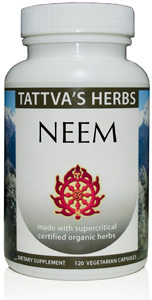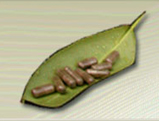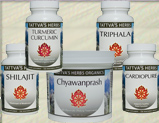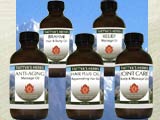
Neem is an evergreen tree from the mahogany family that can grow to 100 feet tall with limbs stretching up to 50 feet across. The neem tree's shiny, dark green serrated leaves range from 2 inches to 1 foot in length. Neem flourishes best in partial shade, but can tolerate full sun and develops a wide canopy atop a narrow trunk.
During mid to late spring, the tree blooms small white flowers that give off a honey-like fragrance. Neem can be found growing wild in Burma, India, Nigeria and various other locations throughout Southeast Asia. Neem fruit has thin yellow-green skin, a bittersweet fleshy pulp and seeds that are used in the production of neem oil.
Neem as the "Village Pharmacy"
To the novice, neem bares a striking resemblance to the Chinaberry tree (except that the Chinaberry tree features purple rather than white flowers). Take care to differentiate the two, as every part of the Chinaberry tree is strongly poisonous. Neem, on the other hand, has long been referred as the "village pharmacy" due to the large number of medicines and herbs that can be distilled from it's various parts.
Neem Use for Oral Health
Today, several manufacturers use neem as the active ingredient in toothpaste and mouthwash products. They believe that neem, unlike the highly toxic fluoride, can compliment oral health without the use of poisons. Despite neem's non-toxicity, it is advisable to rinse the toothpaste out rather than swallowing it.
Neem Oil Extraction
The small olive-like fruit and seeds of the neem tree are pressed to create neem oil. The oil is light to dark brown in color, has a strong garlic and peanut type odor and is very bitter. The trigyceryide compounds it contains cause the odor and bitterness.
While neem oil can be extracted chemically, Ayurvedic and modern medicine practitioners recognize that cold pressing produces the finest and purest oil. During the cold pressing process, raw neem seeds and fruit are pressed mechanically while being kept at very low temperatures, to assure a consistently pure and unsullied product.
Neem Oil and Dermatological Health
Ayurvedic practitioners have used neem oil for thousands of years to maintain healthy skin. Researchers have found that neem oil contains terpenoids, which have antibacterial properties. This may be the reason that people have had success using neem oil to maintain healthy recovery time from burns, cuts and scrapes.
Neem Oil and Pest Control Uses
Neem oil has been show to be an effective deterrent to insects like mosquitoes, both as applied to the skin as an insect repellant and when sprayed on plants and crops as an organic insecticide. Because neem oil is hydrophobic (does not mix with water), when used as an insecticide it must be mixed carefully with an emulsifying agent to achieve good results. This is unnecessary when used as insect repellant--just rub it into your skin to keep mosquitoes from biting.
To create neem insecticide, combine 30 ml of neem oil for every liter of water and stir well. Add an emulsifier to ensure that the mixture does not separate. Spray plants with the mixture during a cool time of day, preferably early morning or dusk for best results, and do not use the mixture after it has been around for about three weeks since it will loose its efficacy.
Neem Extract Capsules
Truly a "Village Pharmacy," neem also has health benefits when taken orally in the form of neem extract capsules. Neem capsules should be made from organically grown neem to avoid any type of heavy metal contamination. At Tattva's Herbs, our Supercritical neem extract capsules contain 70 percent neem extract and contain no synthetic ingredients or animal products.
Recommended oral dosages of neem extract capsules range from 1 to 2500 mg capsules per day. These dosages may be lowered by your doctor to suit your particular needs.

 Loading... Please wait...
Loading... Please wait...













